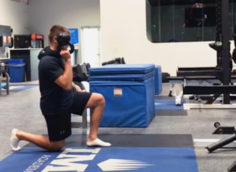Here's a common misconception about biceps: you need to consistently increase the weight to build more muscle.
False. Not with curls at least.
The ceiling of loading potential for isolation exercises is pretty low. The biceps curl involves flexion and extension of just one joint: the elbow. And compared to the triceps, your biceps are a lot smaller and weaker.
So with a movement that's naturally short (bending your arms up and down), and for a muscle group that's relatively weak compared to the rest of your body, how do you create an adaptive response?
By trying out some new exercises with new angles and new tools. Like these:
This variation has a ton of benefits. The hanging kettlebell's inconsistent resistance will place greater demand on the arms and core to stabilize the weight as you curl.
The wider grip on the end of the barbell will place a greater demand on your forearms. It'll also give you the ability to load more weight than you could with dumbbell concentration curls.
I'm borrowing this method from Christian Thibaudeau who has shared similar curl variations before.
Stick your butt against the wall and glue it there. Now tilt over and stay forward throughout your set.
This creates a longer lever in the biceps since they're working through a greater range of motion. This also minimizes potential swinging/momentum.
Tip: Flex your triceps at the bottom of each rep as you lock out your arms. This stabilizes the elbows and offers a greater contraction in the opposing muscles (the biceps).
Sometimes all it takes to create an adaptive response in your muscles is to use different tools. Kettlebells are great for this, and they don't tend to get the attention they deserve when it comes to building arms.
Bottoms-up means upside down, where the large base of the kettlebell is above the handle. This is insanely difficult to do with heavy weights so err on the side of caution.
The key is to grip the middle of the handle tightly. If you ever wanted Popeye forearms, this will be your can of spinach.
You've probably seen something similar in the gym where a guy or girl grabs a couple of light dumbbells and flails their arms in and out to "warm-up their shoulders" or "work their upper back."
The problem? There's no resistance against the shoulders as they rotate. So the key here is to put the band around your wrists, otherwise this exercise would be pointless.
Curl the dumbbells up to 90 degrees, externally rotate the shoulders while keeping your elbows tucked in to your sides, and return back to your starting position.
You'll get some upper back work while adding an isometric contraction in the biceps.
I'll preface this by saying that if someone's waiting to use the squat rack, they have every right to kick you out, or at least give you dirty looks while you do your set. So maybe save this one for your garage gym.
A common trait among these exercises is to create longer levers in the biceps and eliminate potential swinging. This variation does both. You'll get a great contraction at the peak of the curl to grow that baseball.
Using momentum – i.e. hip-thrusting the weight up – is a common error. To eliminate this, set up an upright bench and press your pelvis against it. The weight you use here will be a bit of an ego hit since you won't have the ability to dry hump the air and swing the dumbbells up.
Curl the dumbbells up in the normal fashion, switch to a palms-down grip at the top and lower.
This is a great finisher. Blast out as many reps as you can. Go for complete muscle fatigue. You should feel like your arms are going to explode, or you're about to shit yourself. Or both.
Just remember, you don't need to consistently use heavier weight on isolation exercises if your goal is to build muscle. Sometimes, all you need is to switch things up. These exercises will keep you busy for a while.





